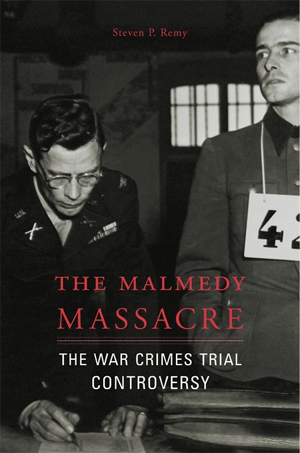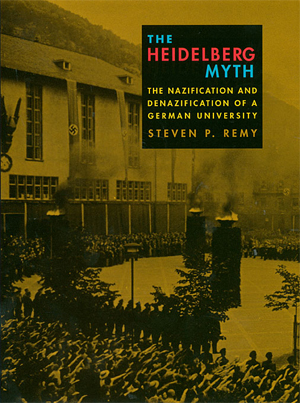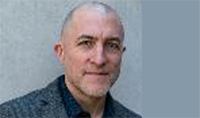Dr. Steven Remy earned a Ph.D. in History, as well as a Contemporary History Certificate, from Ohio University in 2000. He is currently Professor of History at Brooklyn College and has recently completed his second book, The Malmedy Massacre: The War Crimes Trial Controversy (Harvard, 2017).
The Contemporary History Institute recently caught up with Remy, who provided some insight into his career.
You are currently teaching at Brooklyn College (CUNY). How long have you been teaching there? What courses are you currently teaching? Are there any that are particularly exciting for you, or that you feel generate an exceptional amount of enthusiasm from students?
I have been teaching at Brooklyn College and the CUNY Graduate Center since 2002. Most of my teaching this semester has a global scope. I’m teaching an undergraduate elective on Europe after 1945. It’s been a few years since I’ve taught that course, and I had to update the back end of it substantially to include the resurgence of the populist right as a European and global phenomenon, the refugee crisis, the war in Ukraine, and Brexit. An unpleasant but necessary task.
I’m also teaching an M.A.-level course on main currents in modern global history, in which I introduce students – most of them social studies teachers – to very recent scholarship on imperialism, globalization, the anthropocene, the Haitian revolution, debates about the relationship between slavery and capitalism, the “great divergence” thesis, global populism, and some interesting new work on racialized structures of power and privilege.
The class I’m most excited about is another M.A. course on armed conflict in the imperial world from roughly the late 1800s to, roughly again, the 1970s. This one is related to a new book project. I’m challenging students to rethink what they know about World Wars I and II in particular. They’ve been reading recent scholarship on the role of empires in both conflicts and some really excellent new work on World War II in Africa, India, and China. It’s been generating lively discussions.
You have written two books, the most recent having been released in 2017. What is the focus of your research? Where have you conducted your research? Do you have any ideas for your next project?
 Both The Heidelberg Myth and The Malmedy Massacre deal with contested memories. Both also contribute to an ongoing attempt by historians to untangle what we, and the wider public, know about National Socialism, World War II, and the Holocaust from the influence of former Nazis and their sympathizers. I did the bulk of the research for both books in Germany and at the National Archives in College Park, Md.
Both The Heidelberg Myth and The Malmedy Massacre deal with contested memories. Both also contribute to an ongoing attempt by historians to untangle what we, and the wider public, know about National Socialism, World War II, and the Holocaust from the influence of former Nazis and their sympathizers. I did the bulk of the research for both books in Germany and at the National Archives in College Park, Md.
Now I’m contemplating two new projects. One deals with the history of the postwar German radical right, about which we know far too little, particularly in the first postwar decades. Recent events in Germany and Europe sparked my interest in this topic. I was living in Berlin in late 2011, working on The Malmedy Massacre, when the National Socialist Underground story broke. The NSU was a group of young neo-Nazis who managed to carry out a decade-long killing, bank robbing, and bombing spree under the noses of multiple German law enforcement agencies.
That incredible story piqued my interest in the longer-term history of the far right, as has the surge in popularity of the Alternative for Germany party and the “PEGIDA” movement. Right now I’m going through some recently declassified records from the West German equivalent of the FBI that I found in Germany last summer and pairing those with declassified American intelligence files from the National Archives.
The other project – on armed conflict in the imperial world – was inspired by my students, who come from all over the world. In courses I’ve been teaching on the topic, we’ve been rethinking “World War I” and “World War II” as part of a longer term, interconnected series of armed conflicts over building, defending, and fighting empires. The book I have in mind would be a synthesis for a general readership.
Where have you been able to lecture or give presentations on your work?
 I’ve been fortunate to be able to give talks on both my books in Germany. After The Heidelberg Myth was published, I gave presentations at the Ruhr Universität Bochum, at the Institut für Zeitgeschichte in Munich, at the Simon-Dubnow-Institute for Jewish History and Culture at Leipzig university (Chester Pach arranged for me to spend a semester there in 1993 or 1994), and the Kulturwissenschaftliches Institut in Essen. It was a particular pleasure to give a talk on the book to a large audience at Heidelberg university. When I was doing research for The Malmedy Massacre, I was a guest researcher at Norbert Frei’s Center for 20th Century History at the Friedrich-Schiller Universität in Jena – the German equivalent of CHI – and presented my work to date on the book.
I’ve been fortunate to be able to give talks on both my books in Germany. After The Heidelberg Myth was published, I gave presentations at the Ruhr Universität Bochum, at the Institut für Zeitgeschichte in Munich, at the Simon-Dubnow-Institute for Jewish History and Culture at Leipzig university (Chester Pach arranged for me to spend a semester there in 1993 or 1994), and the Kulturwissenschaftliches Institut in Essen. It was a particular pleasure to give a talk on the book to a large audience at Heidelberg university. When I was doing research for The Malmedy Massacre, I was a guest researcher at Norbert Frei’s Center for 20th Century History at the Friedrich-Schiller Universität in Jena – the German equivalent of CHI – and presented my work to date on the book.
This was a particularly gratifying honor, given Norbert’s influence on my work and the stellar cohort of scholars and students working at the center. I’ve also appeared in a number of American and British television documentaries dealing with various aspects of the history of Nazi Germany. The most memorable experience was filming two episodes of Nazi Mega Weapons – on the SS and on Hitler’s eastern front headquarters – in Germany. For the segment on concentration camps, the producers got permission to film in parts of Dachau long closed to the public, now part of a Bavarian state police facility, including what remains of the very first structure used to hold prisoners.
How did your education at the Contemporary History Institute help prepare you for your career?
Most important was the quality and dedication of the faculty and my fellow students. Having access to Brown House for classes, meetings, guest lectures, and as a space to work and interact with people was another essential component of the program. As we were a bit isolated in Athens, it was also extremely important that John Gaddis, Chester Pach, Steve Miner, Alonzo Hamby, Jeffrey Herf, and others invited a stream of guests to give talks, meet with our classes, and occasionally have dinner with some of us.
I used to jump at the chance to drive to Columbus to pick them up at the airport. It would give me a good two hours to talk one-on-one with people like William McNeill, Richard Breitman, Akira Iriye, and others. I also brought Jeff Herf to Ohio University for his interview and established a good rapport with him from the start. He supervised my dissertation, which became The Heidelberg Myth, and we’re still in regular contact.
The larger point is that the guest speakers, along with the Baker Peace Conference, served as a kind of parallel, ongoing seminar that engaged us intellectually and professionalized us. It was really a very valuable part of our experience. Like some other members of my cohort, I have a shelf in my office dedicated to books published by former CHI students. It serves as a constant source of inspiration, and it keeps growing in size.
I feel I belong to an important network whose members share a connection to a very special place. To give you just one recent example – in two weeks I’ll be hosting the award winning documentary filmmaker Blair Foster, a CHI alum, at Brooklyn College. It’s fun to now be the one connecting highly accomplished professionals with students and colleagues.
- Visit CHI’s Facebook page for regular updates on lectures, events, and other matters of interest related to the Institute.




















Comments